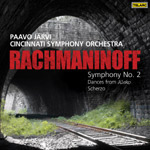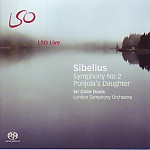|
You are reading the older HTML site Positive Feedback ISSUE march/april 2007
Rachmaninoff and Sibelius
Rachmaninoff, Symphony No. 2. Scherzo Dances from Aleko, Paavo Jarvi, conductor. Cincinnati Symphony Orchestra, Telarc Hybrid SACD 60670 This introduction is almost identical to that for the aforementioned Sibelius Symphony number two. When lists of recommended composers are released to aid newcomers to classical music, Sergei Rachmaninoff's name is always found. When lists of recommended symphonies are released, there is Rachmaninoff's name next to the words Symphony number two. His name will also be listed with piano music (solo and concertos) as well as my personal favorite Rachmaninoff composition, Rhapsody on a Theme of Paganini. Rachmaninoff actually started his musical composing career with the opera, Aleko. Two dances from that early opera, the "Women's Dance" and the "Men's Dance" are included on this release. Each has a hint of exotic or gypsy atmosphere. The third added composition is actually Rachmaninoff's first orchestral work and is simply entitled Scherzo. Scherzo typically refers to a section or movement of a larger work. No one has any idea what the larger work was or was going to be. It is simply an almost five minute long simple, very lyrical first orchestral composition and first performed fifty-seven years after it was written. Rachmaninoff almost did not have a career as a symphonic composer. The premiere of his First Symphony was reported to be a disaster; a poor performance taken to extremes by an inebriated conductor, did not need the added weight of harsh critics to sink him into deep depression lasting for at least two non-composing years. Some years later the instant success and popularity of his Second Piano Concerto launched a long and extremely successful touring career. Eventually, seven years after that, he conducted the premiere of his Second Symphony to critical and popular success. It is probably his most popular purely orchestral composition. Scored for a large orchestra, the overall mood is ever changing in the four movements. The same thing can be said of most of Tchaikovsky's larger works. Impressions created by the music range from brooding or melancholy to lyrical or melodic beauty and even to wistful or dreamlike passages. At a number of places, passages are heard, briefly, for solo clarinet. In the third movement, the beautiful so-called love theme develops with a number of solos from a half dozen different instruments. As would be expected of any symphony written by a Russian composer (except for Tchaikovsky's Sixth or Pathetique) the lyrical passages develop into a fittingly extroverted finale. Almost all first time listeners enjoy this appealing work (as is true also of Sibelius' Symphony No. 2). Jarvi and the Cincinnati Symphony Orchestra are fully up to the demands of this richly scored composition. As has become typical of Telarc lately the recorded sound quality on the SACD layer of this fine hybrid disc is "almost as good as it gets." Some of the drum thwacks are not as solid and percussive as possible and though the brass section is clear and detailed (actually all instruments are clearly and cleanly revealed even in quieter passages) they still do not cut through the overall fabric with startling presence as they do in the concert hall. So, once again it is easy to give a Telarc classical music recording a highly recommended designation. To classical music listeners, I repeat the advice to keep buying the SACD hybrid version of new releases, so the companies will keep making them, knowing we want the best sound possible from recordings now and in the future.
Sibelius Symphony No. 2. Sir Colin Davis conductor, London Symphony Orchestra LSO Live SACD Hybrid LSO 0605 When lists of recommended composers are released to aid newcomers to classical music, Jean Sibelius' name is always found. When lists of recommended symphonies are released, there is Sibelius' name next to the words Symphony number two. Any listener enjoying this excellent and very satisfying symphony, is advised to purchase a collection of Sibelius' very enjoyable tone poems. Make sure that his most famous compostion, Finlandia is included. Anyone desiring to venture more deeply into serious classical music should try his outstanding violin concerto as well as his Symphony five. Here we have a finely crafted performance combining the very experienced and often recorded (including this symphony) Colin Davis, and the now widely acclaimed London Symphony Orchestra. Colin Davis has a long history of recorded performances with many composers and often with generally acclaimed excellence. Davis is seemingly rerecording much of the catalog, often for a third time. It is logical to believe and I agree that his latest conducting efforts are carefully and thoroughly thought out to showcase his ultimate legacy to the musical world. Many conductors emphasize the stark and bleak background of much of Finland in their interpretations of many of Sibelius' compositions. Here Davis seemingly lets the music speak for itself with little in the way of added emphasis. The result is a seemingly relaxed overall feeling with beautiful rapport with the London Symphony Orchestra. Overall an excellent choice for those new to symphonic music as well as for anyone desiring to add an outstanding version to his or her collection. The recording can only be described as thoroughly sympathetic with the overall superb performance and much of that credit rests with the musically natural sound quality revealed by the SACD layer. Much of the perspective is heard as if we are listening from a seat about half way (or a bit more) back in the Barbican Center. This might be the best reproduction yet of the LSO's string section and is ably supported by the overall perspective. The brass and winds do not cut through the general recording fabric with as much presence as in a live performance in this case. In live performances, the brass instruments seem to clearly cut through the overall orchestral presentation with their leading edge very apparent. This recording is highly recommended and the added tone poem, Phojola's Daughter is a good introduction to Sibelius' tone poems. Addendum #1 For lovers of live classical music be advised of a perhaps unique situation for a summer vacation. Starting July 20,2007 and until July 28, the London Symphony Orchestra will be performing in concerts at the moderately sized Peabody Auditorium in Daytona Beach, Florida. The selections are outstandingly good and include Beethoven's Symphony No 9 (Choral). Contact info at: www.fif.lso.org or call (386) 257-7790. Addendum #2 For those interested in historical trivia on Sibelius' recorded Symphony No. 2: Sir Thomas Beecham conducted this symphony nearly fifty times during his career. On Sibelius 89th birthday in 1954, Beecham conducted this work in Sibelius' honor on a BBC broadcast with Sibelius listening in Finland. It is now available on a mono BBC CD. Beecham's only commercial recording of this symphony was done eight years earlier and is only available on a mono LP.
|


